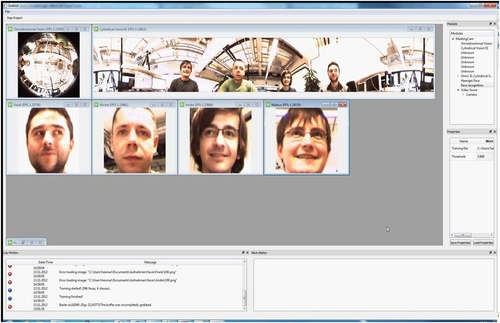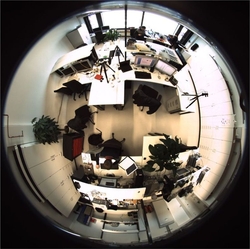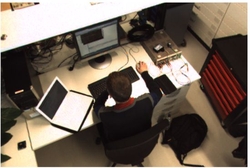Camera Models and Calibration
In order to use cameras (optical sensor) for measurements, a detailed knowledge of the underlying camera model is essential. Therefore, an accurate estimation of the camera model parameters and resource-efficient implementation is necessary.
The professorship DST deals with the mathematics of different camera models (e.g. perspective, cylindrical, omnidirectional projection) and the corresponding calibration methods, as shown in Figure 1 for an omnidirectional meeting camera.

Fig 1: Meeting Camera - An omnidirectional view is converted to a panorama, which is evaluated by a face recognition. The detected faces are displayed as a perspective projection.
Especially the omnidirectional cameras have become more and more important in recent times, e.g. in the automotive industry. Their very large detection range (viewing angle = 180°) also makes them attractive for surveillance applications. A single sensor can fully monitor a room. For the use of certain image processing algorithms as well as for human processing a partial rectification respectively a partial change of the camera models is necessary. This methodology, also known as vPTZ (virtual Pan Tilt Zoom) camera, is further developed by DST. Figure 2 shows the generation of virtual perspective views from an omnidirectional projection.
Publications
| Title | Author(s) | Year | |
|---|---|---|---|
| 1 | Automated Real-Time Surveillance for Ambient Assisted Living Using an Omnidirectional Camera
2014 IEEE International Conference on Consumer Electronics (ICCE). - Las Vegas : IEEE, 2014. - pp. 402-405 |
Meinel, Lars Findeisen, Michel Heß, Markus Apitzsch, André Hirtz, Gangolf |
2014 |
| 2 | A fast approach for omnidirectional surveillance with multiple virtual perspective views
EUROCON 2013, 1-4 July 2013, Zagreb, Croatia, 1578 - 1585 |
Findeisen, Michel Meinel, Lars Heß, Markus Apitzsch, André Hirtz, Gangolf |
2013 |


